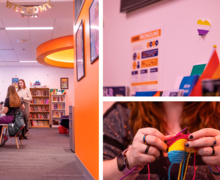The Emergency Triage, Treat and Transport project can tackle certain healthcare issues
Meghan Hendricks | Photo Editor
For many in Syracuse, an uninsured trip to the hospital can be crushing. But ET3, a new federally-funded project, aims to mitigate this and must be given our support.
To support student journalism and the content you love, become a member of The Daily Orange today.
Healthcare is a human right that Americans without wealth are not always privy to. Although the American healthcare system provides a wide range of services, it is a messy, corrupt web.
A sector that consistently lacks proper service for its patients is emergency medical services. Traditionally, EMS has been the practice of pre-hospital treatment for serious medical or traumatic incidents.
But Emergency Triage, Treat and Transport, or ET3, a new federally-funded five year pilot project, aims to break the conventional mold and make emergency medical care more accessible. ET3 allows selected EMS agencies to provide physician care from the comfort of someone’s home or the back of an ambulance via telehealth. EMS workers and patients speak with doctors over the phone to make the decision on whether or not to take a trip to the emergency room.
The unacceptable structuring of the healthcare system in the United States forces people to call EMS for non life-threatening reasons that would not traditionally qualify as issues requiring ambulance transport, making Americans waste money they don’t have. According to a 2020 study, the average cost of a trip to the hospital via ambulance is $1,277 in America. This cost does not stand alone — tacking on an average cost of 1,668 dollars for emergency room fees in New York state raises the price of care significantly.
Due to the nature of ET3 being a pilot program, an individual cannot call specifically for this resource. But in Syracuse, the city’s main EMS provider, American Medical Response, is a selected agency that has specific calls that are not life-threatening directed to them because of their ET3 capabilities. From there, if the patient is prescribed a solution to their ailment via telehealth, they can refuse ambulance transportation and return to life as usual. If the doctor deems their illness serious enough for transport, they will direct them to an “alternative destination partner,” which includes urgent care clinics and similar facilities. This way, they are not subjected to exorbitant emergency room wait times and costs.
Specifically in the city of Syracuse, a recent Census Bureau study shows that one third of residents are in poverty, and 38.1% of Syracuse families with at least two children make less than $35,000 per year. A single uninsured trip to the emergency room using an ambulance could cost an individual or family one tenth or more of their yearly income.
ET3’s mission is to mitigate this — to lower absurd costs by allowing patients who are not suffering from a major trauma or an immediately life-threatening medical emergency to speak with a doctor over the phone and receive treatment. If no transport occurs, the only fee the patient is responsible for is the copay for possible medication — which is similar to the cost of a regular visit to a physician — rather than the thousands of dollars spent in ER care.
Affordable health insurance is unattainable for a staggering amount of Americans. A national survey released by the Biden-Harris administration shows that over 26.5 million Americans are without healthcare. This survey does not account for the 43% of American people who have some form of health insurance but are inadequately insured.
In packed emergency rooms, doctors and nurses are scrambling to treat people with higher acuity issues and do not have time to look for cheaper options. Yet, with ET3, individuals who need medicine and are without insurance often get discounted prescriptions, since telehealth doctors have time to find better alternatives.
Good patient care goes beyond simple treatment. Having a one-on-one telehealth interaction improves a patient’s experience with EMS and morale. In Syracuse and much of the U.S., emergency rooms are overflowing with patients, especially since the pandemic started. With COVID-19 ongoing, emergency room capacities being stretched puts pressure on overworked nurses and doctors. ET3 would help in relieving this issue. Doctors practicing under ET3’s scope are able to focus solely on the person in need of care.
Susie Burnett, a NYS paramedic and professor, said a person who has asthma and is not in respiratory arrest is an ideal candidate for ET3. In Syracuse, racist city planning suffocates people of color and low income communities who suffer from asthma at significantly higher rates than those not constantly exposed to dangerous air quality.
Burnett adds that when someone runs out of bronchodilator in their emergency inhaler, if an ambulance service offering ET3 is able to respond, they can treat the asthma-related issue on scene and prescribe the patient another inhaler. Burnett highlighted how special this is, because EMS providers can treat the impending life threat and hold the person over long enough to hopefully get a more secure supply of their medicine. This same type of scenario could be applied to many medical issues EMS workers see on a daily basis.
If funding to programs like ET3 increases, important issues within the healthcare system can be tackled, beginning at the stress put on the healthcare system being lowered. Along with dropping costs, EMS workers, nurses and doctor’s mistreatment of patients would likely reduce as well. Private and federal EMS and healthcare suppliers would have more money to pay providers fair wages. Pay increase would incentivize good people to stay in the field they love and allow companies to weed out problematic individuals providing essential life saving services.
All of us are at risk of needing to call an ambulance at any point in time. Thankfully, built into student healthcare, SU and ESF students have access to free ambulance services through Syracuse University Ambulance. The privilege of free ambulance transport is not shared by all but it absolutely should be. Even then, SUA does not provide ET3 to all.
As Susie Burnett said in reference to ET3 as a service, “this isn’t the future, this is now.” As a community and nation, we need to make sure programs like this are funded and well researched to make certain equal access to quality of life for all. ET3 is not the absolute answer, but it is a massive stride in the right direction.
Conor Sarasin is a Junior Environmental Studies Major. His Column appears bi-weekly. He can be reached at cjsarasi@syr.edu.
Published on January 25, 2023 at 12:43 am






